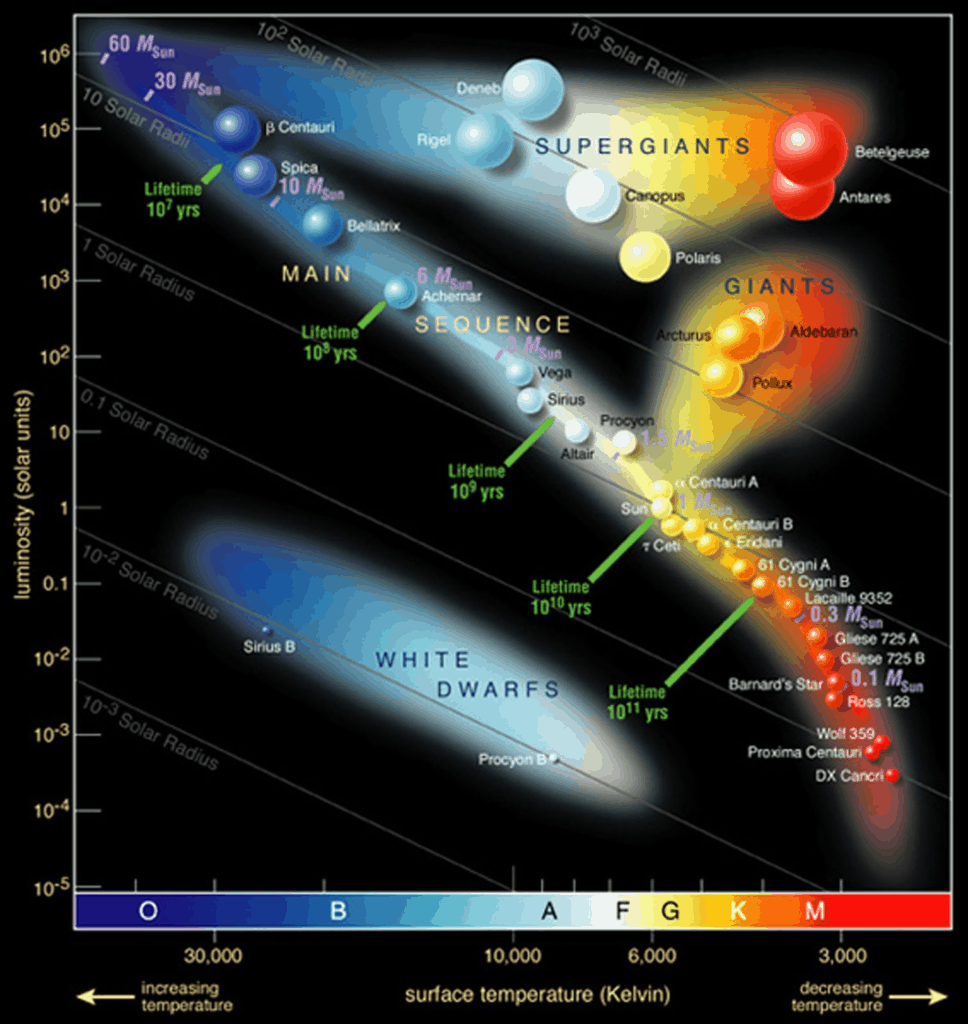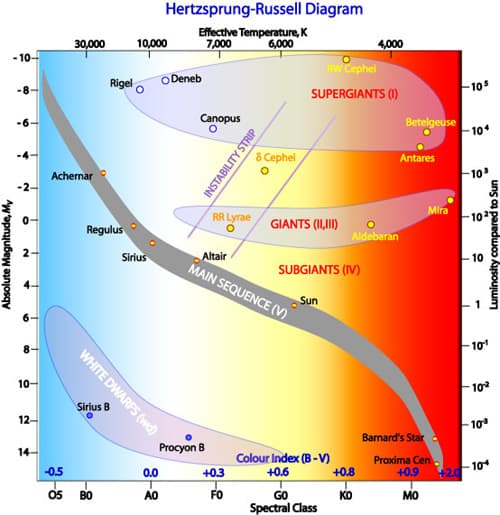For ages, people have gazed at the night sky and got amazed by the beautiful spectacle above them. Despite being upstaged nowadays by the city lights, stars have been romanticized for decades in books and movies. Now, why some of them are different colors? This article will explain it below.
Why Are Stars Different Colors?
Planets, planetoids, and other stellar bodies come in many sizes, shapes, and colors. The same goes for stars, something that astronomers have discovered after centuries of investigation. Their research also suggests that several factors can affect their color.
Without a telescope, one could assume that all stars are white. However, scientists have found that there are various kinds of lights and wavelengths, which can be wide or tightly packed. Additionally, different wavelengths can generate different colors. When it comes to stars, they’re affected by their temperature, thus, producing light in different colors.
Wavelength Changes
One thing that can alter a star’s colors are elements in its atmosphere. Most of the time, they change the light’s wavelength which explains why there are so many colors. This is because the hydrogen, helium and trace elements that make up a star can alter its electromagnetic radiation when heated. This combination is what scientists refer to as a Planck’s curve.
The wavelength at which a star emits the most light is called peak wavelength or Wien’s Law. Unfortunately, the way the light appears to the human eye is mitigated by its spectral radiance and wavelength. The change in color a star’s component add can be studied by spectroanalysis, which examines the various wavelengths it produces using a spectrometer and determines what elements are being burned inside.
Another factor is the star’s temperature. The hotter it is, the higher the radiated energy and the peak of the curve moves to shorter wavelengths. Colder stars experience the opposite phenomenon, but this will be explained below. The Doppler Effect also figures among the reasons why stars change color since the frequency of light can increase or decrease based on the distance between the source and the observer.
Astronomers often use filters to measure a star’s apparent brightness. They only transmit the light from a narrow band of wavelengths. The most commonly used filters are U (ultraviolet), B (blue) and V (visual, for yellow), which transmit light near the wavelengths of 360, 420 and 540 nanometers. The measure of a star’s brightness in each filter is expressed in magnitudes.
What Color are the Coolest Stars?
The way a star’s temperature affects its color is further explained in ‘blackbody radiation’, which was developed to study this phenomenon. According to what this science stipulates, stars with cooler temperatures have energy that radiates light in red tones while hotter temperatures cause them to appear blue or white. This temperature range has also produce orange, yellow and green stars as well.
The coolest stars are red with a temperature of 3000 celsius. The sun’s orange and yellow glow is because it’s close to 6000 celsius. On the other hand, green stars have been proven to have temperatures of about 10,000 celsius whereas blue stars are the hottest, reaching the 25,000 celsius.

The Hertzsprung-Russell Diagram
Research suggests that the Hertzsprung-Russel diagram is one of the most important tools in the study of stellar evolution since its development in the 1900s by Ejnar Hertzprung and Henry Norris Russell. It relates the stellar classification to the absolute magnitude, luminosity and surface temperature. According to the Hertzsprung-Russell Diagram, every star goes through specific evolutionary stages depending on its initial mass, internal structure and how it produces energy.
Each of the stages corresponds to a change in the star’s temperature and luminosity, which can move to different regions on the HR diagram as it evolves. Therefore, astronomers will be able to know a star’s internal structure and evolutionary stage by determining its position in the diagram. Normally, the Hertzsprung-Russell diagram shows a group of stars in various stages of evolution, the most prominent feature being the main sequence, which goes from hot, luminous stars to cool, faint stars.
There are three main stages in the HR diagram: main sequences, red giants, supergiants and white dwarves. On the first stage, stars are classified from hot, luminous stars to cool, faint stars. Most of their lives are spent burning hydrogen into helium in their cores. Then, there are the red giants and supergiants, which have low surface temperatures and high luminosities, meaning that they have large radii as well. Stars enter this evolutionary stage when they exhaust the hydrogen in their cores and started to burn helium and other heavier elements.

White dwarf stars, on the other hand, are the final evolutionary stage of low to intermediate-mass stars. They can be found in the bottom left of the HR diagram. White dwarves are very hot but have low luminosities due to their small size. Astronomers generally use the diagram to summarize their evolution or investigate their properties, allowing them to estimate the age of a star cluster from where they appear to turn off the main sequence.
From Hottest to Coolest
Stars’ color gradient varies depending on how hot they are. Now, ordering them from hottest to coolest, the first colors on the list are blue, deep blue-white, blue-white and white. Then, once the stars begin to cool down, they can be yellowish-white, pale yellow-orange and light orange-red. Research suggests that stellar classification is a great way of using a star’s color to determine its age.
This is where the Hertzsprung-Russell Diagram comes into play. The temperatures are displayed in the x and y-axis, the former showing temperatures colder than 0 kelvin and the latter showing the luminosity scale. The color gradient in the HR diagram goes from deep blue to orange-red, from hottest to coldest. Knowing about a star’s luminosity and its temperature can also help calculating its age and size.

Main Sequence Star Colors
The hydrogen in main-sequence stars, a category to which most stars belong, is being burned by them. They’re mostly bright, hot blue and very young since they’re burning their fuel violently. Sadly, these don’t tend to live for long despite which is a shame, considering how beautiful they are. Red stars, however, are a whole other story.
Red stars have often the lowest temperature compared to their counterpart. Since they turn their hydrogen into helium at a slower pace, they can exist for longer than the hot stars. An example is the Sun, which has a long way to go before its ten billion year life ends. One interesting thing about red stars is the fact that they’re expected to live for 100 billion years, whereas their hot, blue sisters only last 10 million years.
Once a star has used up its hydrogen, it leaves the main sequence and becomes a different type of star. Depending on its mass, it can become a dwarf, giant or supergiant. According to the Morgan-Keenan classification, a star can also turn into a subdwarf or a hypergiant.
What colored stars can I see?
The type of colored stars that can be seen will rely on the season and whether the area is highly illuminated. Most of the time, they can be seen from the northern hemisphere. Even though stars can be seen in other seasons too, the best one is when they’re at the highest point.
Depending on its size, a star can be easily detected by the naked eye or difficult unless using binoculars or telescopes. Stars and supergiants are the most visible of them all, whereas main-sequence stars and dwarves are harder to spot. Their brightness can also determine whether their colors can be seen or not.
Stars like Betelgeuse and Arcturus, which are both red and orange, respectively, are bright enough to be seen in areas where light pollution is moderate. However, white and blue stars like Sirius and Albireo are barely noticeable unless a small telescope is being used at a dark sky location. However, light pollution can put a damper on things since it makes stargazing harder unless they’re bright enough to be seen without any issue.
Experts recommend using a planisphere, star atlas, or any astronomy software. Another great tip for astronomy enthusiasts is to use a telescope with a 30x magnification and a tripod to look for stars like Albireo. By using the right equipment, some stars may appear as a single exemplar.
Conclusion
Stars can come in many colors, shapes, and sizes. Their color is mostly determined by both their temperature and composition. Also, they’re a great way to determine their age as well. Contrary to what people would normally associate the colors red and blue, the hottest stars are usually white and blue, whereas cold stars can be either orange or yellow. The former tends to burn its hydrogen violently, thus, dying faster, while the latter tends to burn its core at a slower pace, allowing them to live longer. The main sequence stars can change their type when their hydrogen runs out.



